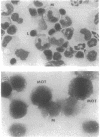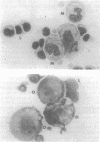Abstract
When cultured in vitro, peritoneal macrophages, obtained from mice previously inoculated with bacillus Calmette-Guérin, release nitric oxide, which is cytostatic and/or cytolytic for tumor cells. However, it is not known whether nitric oxide has antitumor effects in vivo. Here we demonstrate that nitric oxide is an important mediator of host resistance to syngeneic and xenogeneic ovarian tumor grafts in C3HeB/FeJ mice. A murine ovarian teratocarcinoma cell line, utilized to study the mechanism of bacillus Calmette-Guérin-induced host resistance to a syngeneic ovarian tumor, proliferated when transplanted intraperitoneally. Marked tumoricidal activity was observed, however, when these murine ovarian teratocarcinoma cells were transplanted 8 days after intraperitoneal bacillus Calmette-Guérin inoculation. In studies related to xenogeneic ovarian tumor grafts, tumoricidal activity was observed after intraperitoneal transplantation of a human epithelial ovarian cancer cell line, NIH:OVCAR-3. This cell line proliferates only in athymic nude (immunologically incompetent) mice. In both sets of experiments, tumoricidal activity was reduced by inhibition of nitric oxide synthesis. These results demonstrate the tumoricidal action of nitric oxide in vivo.
Full text
PDF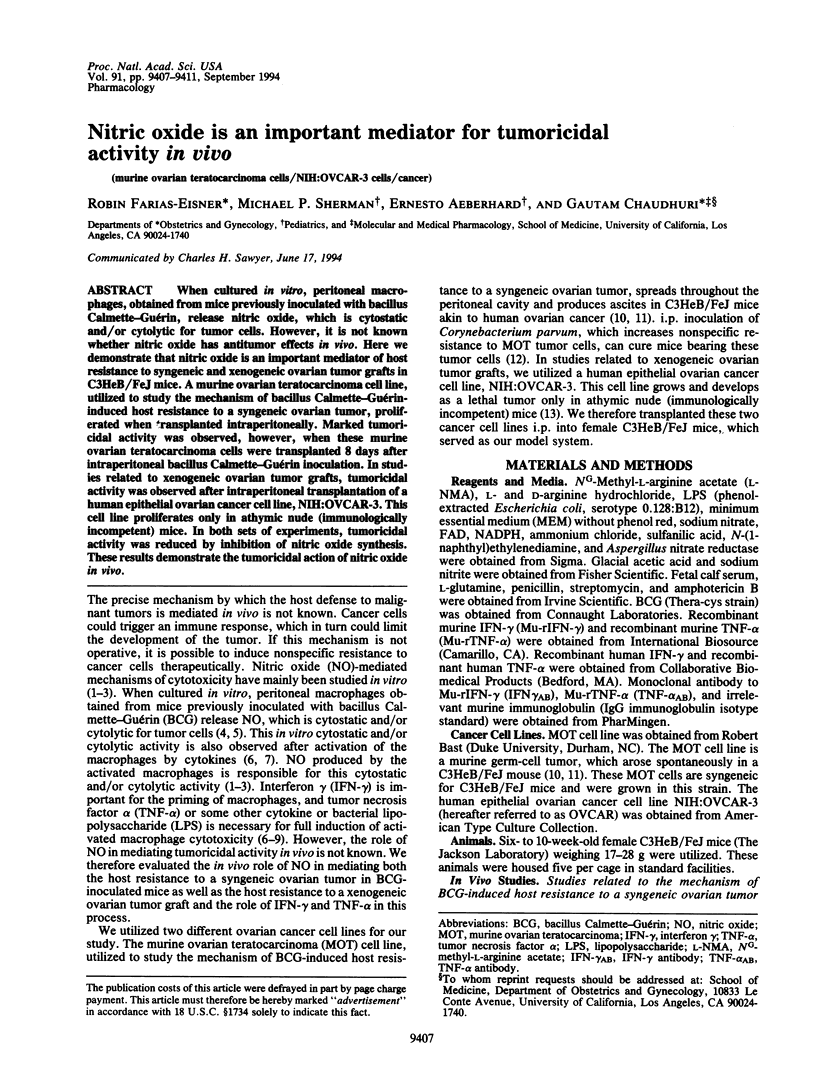
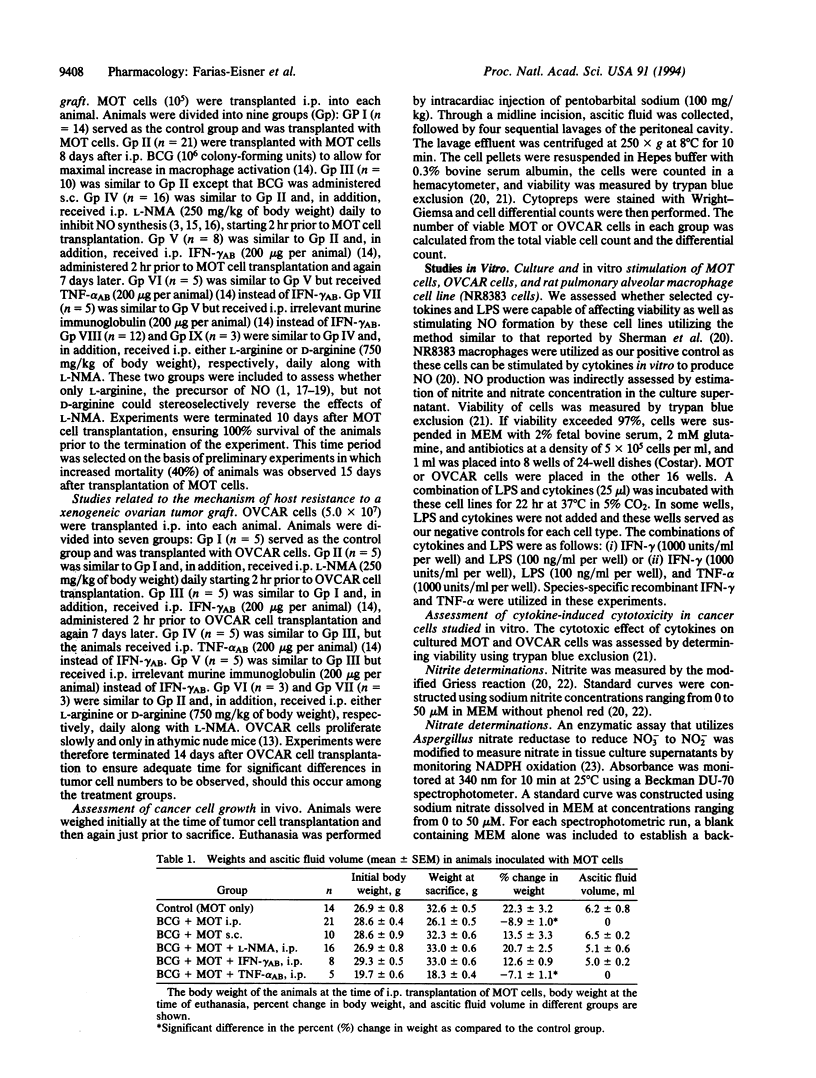
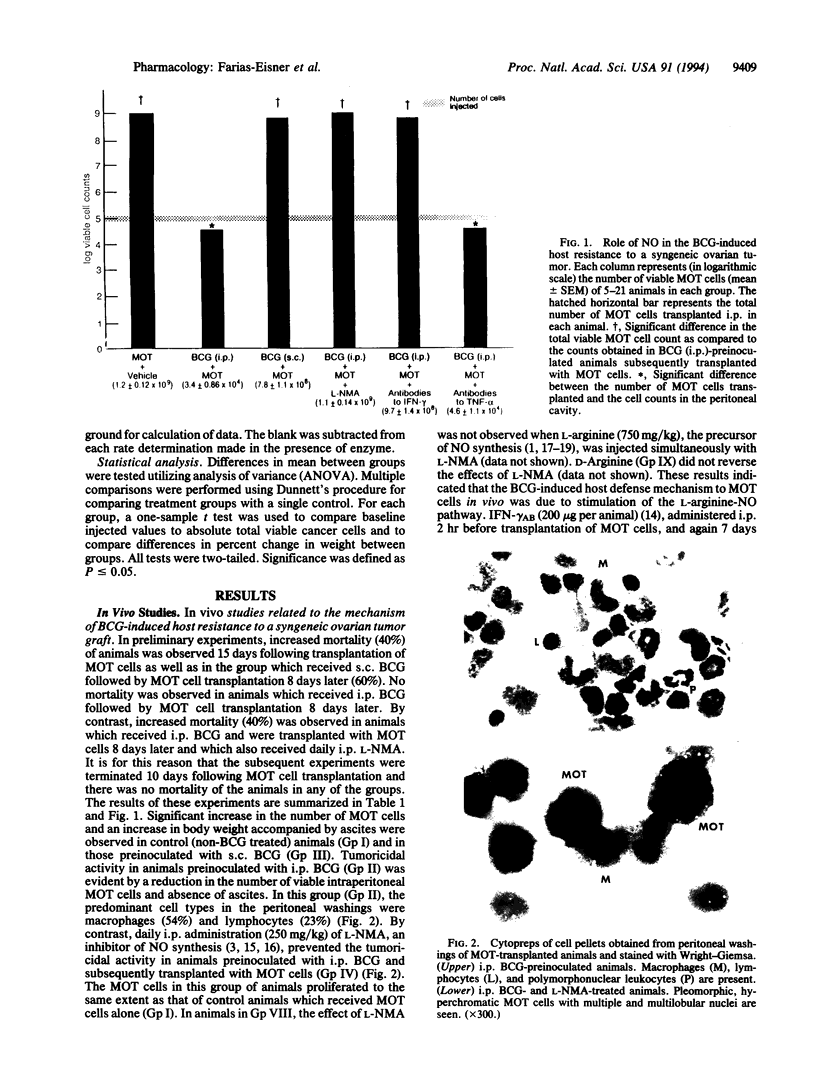
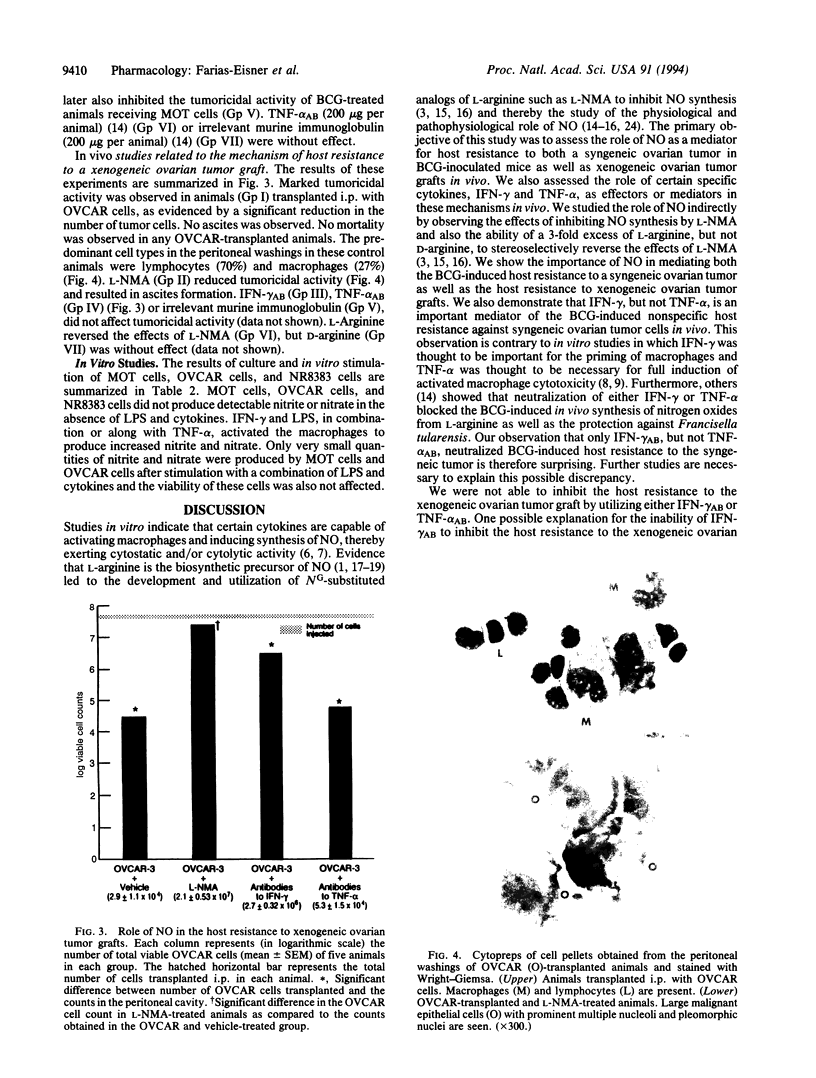
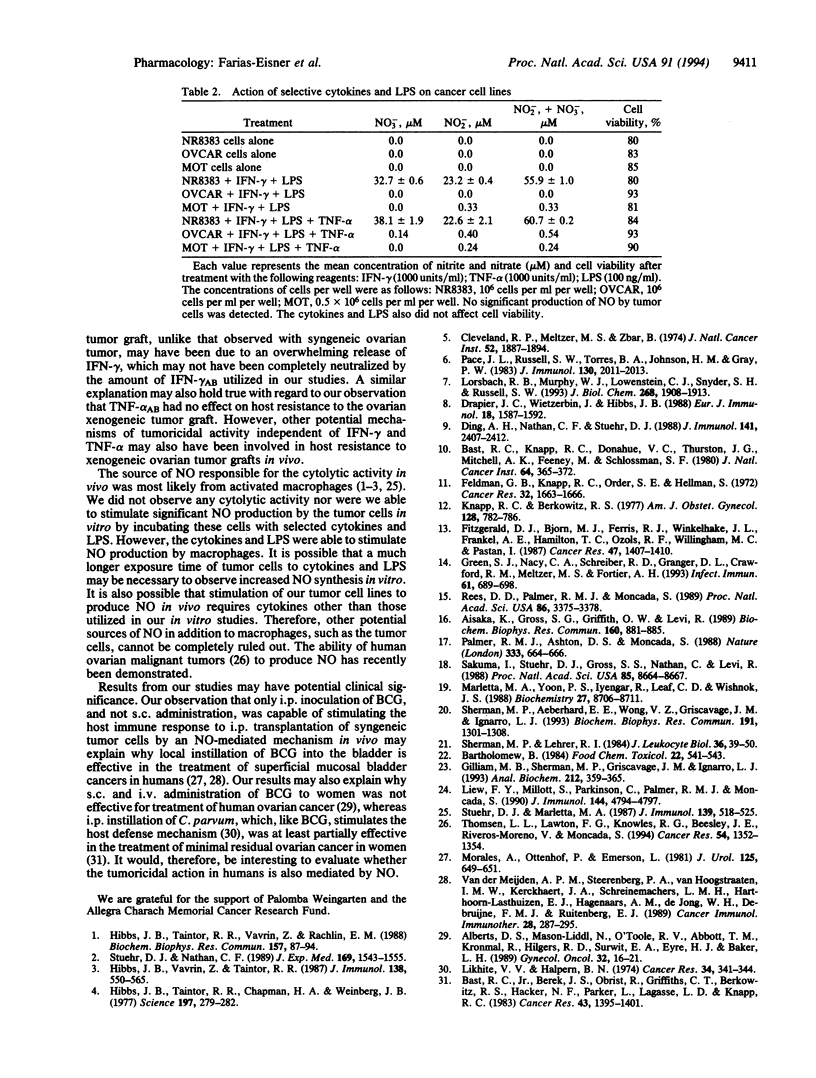
Images in this article
Selected References
These references are in PubMed. This may not be the complete list of references from this article.
- Aisaka K., Gross S. S., Griffith O. W., Levi R. NG-methylarginine, an inhibitor of endothelium-derived nitric oxide synthesis, is a potent pressor agent in the guinea pig: does nitric oxide regulate blood pressure in vivo? Biochem Biophys Res Commun. 1989 Apr 28;160(2):881–886. doi: 10.1016/0006-291x(89)92517-5. [DOI] [PubMed] [Google Scholar]
- Alberts D. S., Mason-Liddil N., O'Toole R. V., Abbott T. M., Kronmal R., Hilgers R. D., Surwit E. A., Eyre H. J., Baker L. H. Randomized phase III trial of chemoimmunotherapy in patients with previously untreated stage III, optimal disease ovarian cancer: a Southwest Oncology Group Study. Gynecol Oncol. 1989 Jan;32(1):16–21. doi: 10.1016/0090-8258(89)90842-1. [DOI] [PubMed] [Google Scholar]
- Bartholomew B. A rapid method for the assay of nitrate in urine using the nitrate reductase enzyme of Escherichia coli. Food Chem Toxicol. 1984 Jul;22(7):541–543. doi: 10.1016/0278-6915(84)90224-2. [DOI] [PubMed] [Google Scholar]
- Bast R. C., Jr, Berek J. S., Obrist R., Griffiths C. T., Berkowitz R. S., Hacker N. F., Parker L., Lagasse L. D., Knapp R. C. Intraperitoneal immunotherapy of human ovarian carcinoma with Corynebacterium parvum. Cancer Res. 1983 Mar;43(3):1395–1401. [PubMed] [Google Scholar]
- Bast R. C., Jr, Knapp R. C., Donahue V. C., Thurston J. G., Mitchell A. K., Feeney M., Schlossman S. F. Specificity of heteroantisera developed against purified populations of intact murine ovarian carcinoma cells. J Natl Cancer Inst. 1980 Feb;64(2):365–372. doi: 10.1093/jnci/64.2.365. [DOI] [PubMed] [Google Scholar]
- Cleveland R. P., Meltzer M. S., Zbar B. Tumor cytotoxicity in vitro by macrophages from mice infected with mycobacterium bovis strain BCG. J Natl Cancer Inst. 1974 Jun;52(6):1887–1895. doi: 10.1093/jnci/52.6.1887. [DOI] [PubMed] [Google Scholar]
- Ding A. H., Nathan C. F., Stuehr D. J. Release of reactive nitrogen intermediates and reactive oxygen intermediates from mouse peritoneal macrophages. Comparison of activating cytokines and evidence for independent production. J Immunol. 1988 Oct 1;141(7):2407–2412. [PubMed] [Google Scholar]
- Drapier J. C., Wietzerbin J., Hibbs J. B., Jr Interferon-gamma and tumor necrosis factor induce the L-arginine-dependent cytotoxic effector mechanism in murine macrophages. Eur J Immunol. 1988 Oct;18(10):1587–1592. doi: 10.1002/eji.1830181018. [DOI] [PubMed] [Google Scholar]
- Feldman G. B., Knapp R. C., Order S. E., Hellman S. The role of lymphatic obstruction in the formation of ascites in a murine ovarian carcinoma. Cancer Res. 1972 Aug;32(8):1663–1666. [PubMed] [Google Scholar]
- FitzGerald D. J., Bjorn M. J., Ferris R. J., Winkelhake J. L., Frankel A. E., Hamilton T. C., Ozols R. F., Willingham M. C., Pastan I. Antitumor activity of an immunotoxin in a nude mouse model of human ovarian cancer. Cancer Res. 1987 Mar 1;47(5):1407–1410. [PubMed] [Google Scholar]
- Gilliam M. B., Sherman M. P., Griscavage J. M., Ignarro L. J. A spectrophotometric assay for nitrate using NADPH oxidation by Aspergillus nitrate reductase. Anal Biochem. 1993 Aug 1;212(2):359–365. doi: 10.1006/abio.1993.1341. [DOI] [PubMed] [Google Scholar]
- Green S. J., Nacy C. A., Schreiber R. D., Granger D. L., Crawford R. M., Meltzer M. S., Fortier A. H. Neutralization of gamma interferon and tumor necrosis factor alpha blocks in vivo synthesis of nitrogen oxides from L-arginine and protection against Francisella tularensis infection in Mycobacterium bovis BCG-treated mice. Infect Immun. 1993 Feb;61(2):689–698. doi: 10.1128/iai.61.2.689-698.1993. [DOI] [PMC free article] [PubMed] [Google Scholar]
- Hibbs J. B., Jr, Taintor R. R., Chapman H. A., Jr, Weinberg J. B. Macrophage tumor killing: influence of the local environment. Science. 1977 Jul 15;197(4300):279–282. doi: 10.1126/science.327547. [DOI] [PubMed] [Google Scholar]
- Hibbs J. B., Jr, Taintor R. R., Vavrin Z., Rachlin E. M. Nitric oxide: a cytotoxic activated macrophage effector molecule. Biochem Biophys Res Commun. 1988 Nov 30;157(1):87–94. doi: 10.1016/s0006-291x(88)80015-9. [DOI] [PubMed] [Google Scholar]
- Hibbs J. B., Jr, Vavrin Z., Taintor R. R. L-arginine is required for expression of the activated macrophage effector mechanism causing selective metabolic inhibition in target cells. J Immunol. 1987 Jan 15;138(2):550–565. [PubMed] [Google Scholar]
- Knapp R. C., Berkowitz R. S. Corynebacterium parvum as an immunotherapeutic agent in an ovarian cancer model. Am J Obstet Gynecol. 1977 Aug 1;128(7):782–786. doi: 10.1016/0002-9378(77)90721-9. [DOI] [PubMed] [Google Scholar]
- Liew F. Y., Millott S., Parkinson C., Palmer R. M., Moncada S. Macrophage killing of Leishmania parasite in vivo is mediated by nitric oxide from L-arginine. J Immunol. 1990 Jun 15;144(12):4794–4797. [PubMed] [Google Scholar]
- Likhite V. V., Halpern B. N. Lasting rejection of mammary adenocarcinoma cell tumors in DBA-2 mice with intratumor injection of killed Corynebacterium parvum. Cancer Res. 1974 Feb;34(2):341–344. [PubMed] [Google Scholar]
- Lorsbach R. B., Murphy W. J., Lowenstein C. J., Snyder S. H., Russell S. W. Expression of the nitric oxide synthase gene in mouse macrophages activated for tumor cell killing. Molecular basis for the synergy between interferon-gamma and lipopolysaccharide. J Biol Chem. 1993 Jan 25;268(3):1908–1913. [PubMed] [Google Scholar]
- Marletta M. A., Yoon P. S., Iyengar R., Leaf C. D., Wishnok J. S. Macrophage oxidation of L-arginine to nitrite and nitrate: nitric oxide is an intermediate. Biochemistry. 1988 Nov 29;27(24):8706–8711. doi: 10.1021/bi00424a003. [DOI] [PubMed] [Google Scholar]
- Morales A., Ottenhof P., Emerson L. Treatment of residual, non-infiltrating bladder cancer with bacillus Calmette-Guerin. J Urol. 1981 May;125(5):649–651. doi: 10.1016/s0022-5347(17)55150-2. [DOI] [PubMed] [Google Scholar]
- Pace J. L., Russell S. W., Torres B. A., Johnson H. M., Gray P. W. Recombinant mouse gamma interferon induces the priming step in macrophage activation for tumor cell killing. J Immunol. 1983 May;130(5):2011–2013. [PubMed] [Google Scholar]
- Palmer R. M., Ashton D. S., Moncada S. Vascular endothelial cells synthesize nitric oxide from L-arginine. Nature. 1988 Jun 16;333(6174):664–666. doi: 10.1038/333664a0. [DOI] [PubMed] [Google Scholar]
- Rees D. D., Palmer R. M., Moncada S. Role of endothelium-derived nitric oxide in the regulation of blood pressure. Proc Natl Acad Sci U S A. 1989 May;86(9):3375–3378. doi: 10.1073/pnas.86.9.3375. [DOI] [PMC free article] [PubMed] [Google Scholar]
- Sakuma I., Stuehr D. J., Gross S. S., Nathan C., Levi R. Identification of arginine as a precursor of endothelium-derived relaxing factor. Proc Natl Acad Sci U S A. 1988 Nov;85(22):8664–8667. doi: 10.1073/pnas.85.22.8664. [DOI] [PMC free article] [PubMed] [Google Scholar]
- Sherman M. P., Aeberhard E. E., Wong V. Z., Griscavage J. M., Ignarro L. J. Pyrrolidine dithiocarbamate inhibits induction of nitric oxide synthase activity in rat alveolar macrophages. Biochem Biophys Res Commun. 1993 Mar 31;191(3):1301–1308. doi: 10.1006/bbrc.1993.1359. [DOI] [PubMed] [Google Scholar]
- Sherman M. P., Lehrer R. I. Superoxide generation by neonatal and adult rabbit alveolar macrophages. J Leukoc Biol. 1984 Jul;36(1):39–50. doi: 10.1002/jlb.36.1.39. [DOI] [PubMed] [Google Scholar]
- Stuehr D. J., Marletta M. A. Induction of nitrite/nitrate synthesis in murine macrophages by BCG infection, lymphokines, or interferon-gamma. J Immunol. 1987 Jul 15;139(2):518–525. [PubMed] [Google Scholar]
- Stuehr D. J., Nathan C. F. Nitric oxide. A macrophage product responsible for cytostasis and respiratory inhibition in tumor target cells. J Exp Med. 1989 May 1;169(5):1543–1555. doi: 10.1084/jem.169.5.1543. [DOI] [PMC free article] [PubMed] [Google Scholar]
- Thomsen L. L., Lawton F. G., Knowles R. G., Beesley J. E., Riveros-Moreno V., Moncada S. Nitric oxide synthase activity in human gynecological cancer. Cancer Res. 1994 Mar 1;54(5):1352–1354. [PubMed] [Google Scholar]
- van der Meijden A. P., Steerenberg P. A., van Hoogstraaten I. M., Kerckhaert J. A., Schreinemachers L. M., Harthoorn-Lasthuizen E. J., Hagenaars A. M., de Jong W. H., Debruijne F. M., Ruitenberg E. J. Immune reactions in patients with superficial bladder cancer after intradermal and intravesical treatment with bacillus Calmette-Guérin. Cancer Immunol Immunother. 1989;28(4):287–295. doi: 10.1007/BF00205239. [DOI] [PMC free article] [PubMed] [Google Scholar]




